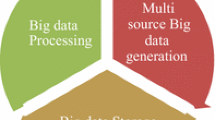Abstract
Smart farming is one of the big concepts that are regarding in the world. It is a development technique for modern agricultures. It generally emphasizes the use of data sensors and data communication technologies in conjunction with an appropriate data analysis technique. Aside from data sensors and data communication technologies, survey questionnaires can also be used to collect the data for developing the smart farming. With survey questionnaires, they are generally proposed to collect the answer about the farmer’s opinion to the specified questions and his/her history data. For this reason, the data sets of smart farming are often the high dimension of quasi-identifier and more sensitive attributes. Moreover, the sensitive attributes of farmer data sets are multiple groups. Thus, privacy preservation models could be insufficient to address privacy violation issues in farmer data sets when they are released for public use. For this reason, an appropriate privacy preservation model for farmer data sets is proposed in this work. Furthermore, the proposed model is evaluated by using extensive experiments. From the results, we found that the proposed model is highly effective than the compared privacy preservation models.






Similar content being viewed by others
References
Bothe A, Bauer J, Aschenbruck N. Rfid-assisted continuous user authentication for iot-based smart farming. In: 2019 IEEE International Conference on RFID Technology and Applications (RFID-TA), 2019;505–10. https://doi.org/10.1109/RFID-TA.2019.8892140.
Fung BCM, Cao M, Desai BC, Xu H. Privacy protection for rfid data. In: Proceedings of the 2009 ACM Symposium on Applied Computing, SAC ’09, p. 1528–35. Association for Computing Machinery, New York, NY, USA 2009. https://doi.org/10.1145/1529282.1529626.
Gal TS, Chen Z, Gangopadhyay A. A privacy protection model for patient data with multiple sensitive attributes. Int J Inf Secur Privacy (IJISP). 2008;2(3):28–44.
Jee SH, Kuo HW, Su W, Chang C, Sun C, Wang JD. Photodamage and skin cancer among paraquat workers. Int J Dermatol. 2007;34:466–9. https://doi.org/10.1111/j.1365-4362.1995.tb00611.x.
Jhuria M, Kumar A, Borse R. Image processing for smart farming: detection of disease and fruit grading. In: 2013 IEEE Second International Conference on Image Information Processing (ICIIP-2013), 2013;521–6. https://doi.org/10.1109/ICIIP.2013.6707647.
Kamilaris A, Gao F, Prenafeta-Boldu FX, Ali MI. Agri-iot: A semantic framework for internet of things-enabled smart farming applications. In: 2016 IEEE 3rd World Forum on Internet of Things (WF-IoT), 2016;442–7. https://doi.org/10.1109/WF-IoT.2016.7845467.
Kohavi R. Scaling up the accuracy of Naive-Bayes classifiers: a decision-tree hybrid. In: Proceedings of the Second International Conference on Knowledge Discovery and Data Mining, KDD’96, p. 202–7. AAAI Press 1996.
Machanavajjhala A, Gehrke J, Kifer D, Venkitasubramaniam M. L-diversity: privacy beyond k-anonymity. In: 22nd International Conference on Data Engineering (ICDE’06), 2006;24. https://doi.org/10.1109/ICDE.2006.1.
Riyana S. (lp1,...,lpn)-privacy: privacy preservation models for numerical quasi-identifiers and multiple sensitive attributes. J Ambient Intell Humaniz Comput. 2021;1–17.
Riyana S, Natwichai J. Privacy preservation for recommendation databases. Serv Oriented Comput Appl. 2018;12(3–4):259–73. https://doi.org/10.1007/s11761-018-0248-y.
Riyana S, Nanthachumphu S, Riyana N. Achieving privacy preservation constraints in missing-value datasets. SN Comput Sci. 2020;1(4):227. https://doi.org/10.1007/s42979-020-00241-9.
Riyana S, Harnsamut N, Sadjapong U, Nanthachumphu S, Riyana N. Privacy preservation for continuous decremental data publishing. In: Chen JIZ, Tavares JMRS, Shakya S, Iliyasu AM, editors. Image processing and capsule networks. Cham: Springer International Publishing; 2021. p. 233–43.
Riyana S, Riyana N, Nanthachumphu S. An effective and efficient heuristic privacy preservation algorithm for decremental anonymization datasets. In: Chen JIZ, Tavares JMRS, Shakya S, Iliyasu AM, editors. Image processing and capsule networks. Cham: Springer International Publishing; 2021. p. 244–57.
Riyana S, Harnsamut N, Soontornphand T, Natwichai J. (k, e)-anonymous for ordinal data. In: 2015 18th International Conference on Network-Based Information Systems, 2015;489–93. https://doi.org/10.1109/NBiS.2015.118.
Riyana S, Riyana N, Nanthachumphu S. Enhanced (k,e)-anonymous for categorical data. ICSCA ’17, p. 62–7. Association for Computing Machinery, New York, NY, USA 2017. https://doi.org/10.1145/3056662.3056668.
Riyana N, Riyana S, Nanthachumphu S, Sittisung S, Duangban D. Privacy violation issues in re-publication of modification datasets. In: International Conference on Intelligent Computing & Optimization, pp. 938–53. Springer 2020.
Sweeney L. k-Anonymity: a model for protecting privacy. Int J Uncertain Fuzziness Knowl-Based Syst. 2020;10(5):557–70. https://doi.org/10.1142/S0218488502001648.
Terrovitis M, Mamoulis N, Kalnis P. Privacy-preserving anonymization of set-valued data. Proc VLDB Endow. 2008;1(1):115–25. https://doi.org/10.14778/1453856.1453874.
Thongprakaisang S, Thiantanawat A, Rangkadilok N, Suriyo T, Satayavivad J. Glyphosate induces human breast cancer cells growth via estrogen receptors. Food Chem Toxicol. 2013;59:129–36.
Tripicchio P, Satler M, Dabisias G, Ruffaldi E, Avizzano CA. Towards smart farming and sustainable agriculture with drones. In: 2015 International Conference on Intelligent Environments, 2015;140–3. https://doi.org/10.1109/IE.2015.29.
Ventura C, Nieto MRR, Bourguignon N, Lux-Lantos V, Rodriguez H, Cao G, Randi A, Cocca C, Núñez M. Pesticide chlorpyrifos acts as an endocrine disruptor in adult rats causing changes in mammary gland and hormonal balance. J Steroid Biochem Mol Biol. 2016;156:1–9. https://doi.org/10.1016/j.jsbmb.2015.10.010.
Wang JD, Li W, Hu FC, Hu K. Occupational risk and development of premalignant skin lesions among paraquat manufacturers. Br J Ind Med. 1987;44:196–200. https://doi.org/10.1136/oem.44.3.196.
Wolfert S, Ge L, Verdouw C, Bogaardt MJ. Big data in smart farming—a review. Agric Syst. 2017;153:69–80. https://doi.org/10.1016/j.agsy.2017.01.023.
Xiao X, Tao Y. Anatomy: simple and effective privacy preservation. In: Proceedings of the 32nd International Conference on Very Large Data Bases, VLDB ’06, p. 139–50. VLDB Endowment 2006.
Zamora-Izquierdo MA, Santa J, Martínez JA, Martínez V, Skarmeta AF. Smart farming IoT platform based on edge and cloud computing. Biosyst Eng. 2019;177:4–17. https://doi.org/10.1016/j.biosystemseng.2018.10.014 (Intelligent Systems for Environmental Applications).
Author information
Authors and Affiliations
Corresponding author
Ethics declarations
Conflict of Interest
Author declares that they have no conflict of interest.
Ethical Approval
This paper does not contain any studies with human participants or animals performed by any of the authors.
Additional information
Publisher's Note
Springer Nature remains neutral with regard to jurisdictional claims in published maps and institutional affiliations.
This article is part of the topical collection “Security and Privacy 2020” guest edited by Pantelimon Stanica, Odelu Vanga and Sumit Kumar Debnath.
Rights and permissions
About this article
Cite this article
Riyana, S., Riyana, N. & Sujinda, W. An Anatomization Model for Farmer Data Collections. SN COMPUT. SCI. 2, 353 (2021). https://doi.org/10.1007/s42979-021-00740-3
Received:
Accepted:
Published:
DOI: https://doi.org/10.1007/s42979-021-00740-3




